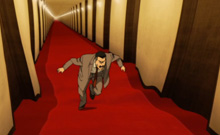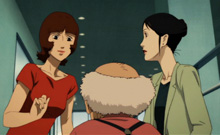Paprika (2006) makes use of animation techniques to manipulate reality at two levels. The first in that we as viewers are seeing something completely unrealistic as it is an animated cartoon but still accepting and immersing ourselves into the reality of the film. Through over-animated facial expressions and emotions imprinted on each character in the film as well as realistic renditions of the city of tokyo and despite the fact they are clearly not real characters, the viewer is still able to connect and understand what is happening within the film. Thus, another way in which animation can manipulate reality.
The second technique is within the film itself and its overarching idea of dreams vs. reality. While seeing the dreams of characters like Shima, Tokita and Himuro, one may be familiar with the multiple settings of the dream, but based on the wild and unrealistic things that happen within them, it is understandable that the dream is not the reality of the doctors who work on the DC mini project. Things like the parade that at first appear only in the dream, but eventually merge with reality and starts consuming everyone in the city, show the power that animation has in manipulating the architectural environment of the scene.











